This article represents the fourth instalment in a six-part series on coaching team defending. This is looking at group tactics, rather than the individual, so whilst individual technique or tactics can certainly be coached if necessary during these sessions, these aren’t the main outcomes of the practices shown in this analysis.
Secondly, as a caveat, these practices shown are just ideas, and may not suit every team, or every age level. However, if they can be used as a framework to generate new ideas or adjusted to make a session, then this article will have done its job. It’s not always advisable to simply “copy and paste” a session plan and apply it to your own team, given that your game model may not suit these practices, or perhaps your team’s current learning curve is not at the level required to run these, or conversely they are at a level where these practices aren’t challenging enough.
Finally, this writer doesn’t claim to be the creator of any practices, however, isn’t knowingly “copying and pasting” ideas himself either. Session ideas and individual practices are, and should be, accumulated over long periods of time, tried, tested, and adjusted, with different teams, age levels and ability levels. As coaches, we should be working collaboratively, sharing ideas and promoting a transparency and openness that helps us and our players achieve our goals. There should be no secrets and it’s so important to share, work together, and support.
Defending in a low block: The session
This set of practices shown in this tactical analysis looks to develop a team’s understanding of defending in a low block. When we talk about a low block we are talking about a team defending in a very deep position, rarely looking to press, and often trying to keep as many men behind the ball as possible. Teams can look to use this tactic when playing against a strong opponent who are possession dominant, and in doing so they will look to defend resolutely before often counter-attacking after soaking up the pressure.
There are specific outcomes we need to draw out of this session. Firstly, when defending in a low block, as obvious as it sounds, we need to prevent the attacking team from scoring. In order to achieve this goal, we need to prevent easy passage through the central channel, whether through link-up play or through passes. We ideally want to prevent the opponent from making crosses easily as well.
In terms of team shape, we want to achieve consistent defensive compactness, both horizontally and vertically, leaving as little space as possible for the opposition to access.
Part 1
A good way to introduce this topic can be achieved through a practice with an offensive overload, giving the defensive team a slightly more difficult task of preventing the opposition from scoring.
The example shown below is a 6v5, with a centre circle space the defensive team are looking to protect. There are four outlet goals for the defensive team to score in if they win possession, giving them motivation to win the ball other than to just defend the space, and allowing the ball to turn back to the attacking team quickly after losing it.
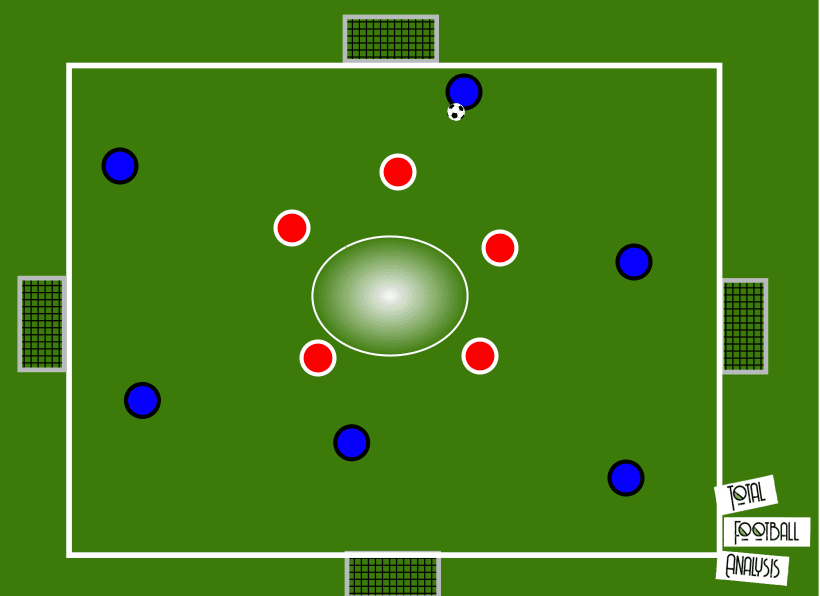
In order for the attacking team to score they need to thread a through pass into the central space and find a teammate making a run into this area. A three-second rule can be put in place to avoid attackers just remaining inside the centre circle and forcing them to have to time their runs.
This forces the defenders to scan out of possession and check for players around them, and potential runs being made into the area. In the example below a red defender recognises the run of the blue attacker and places themselves in a more narrow position to prevent this pass.
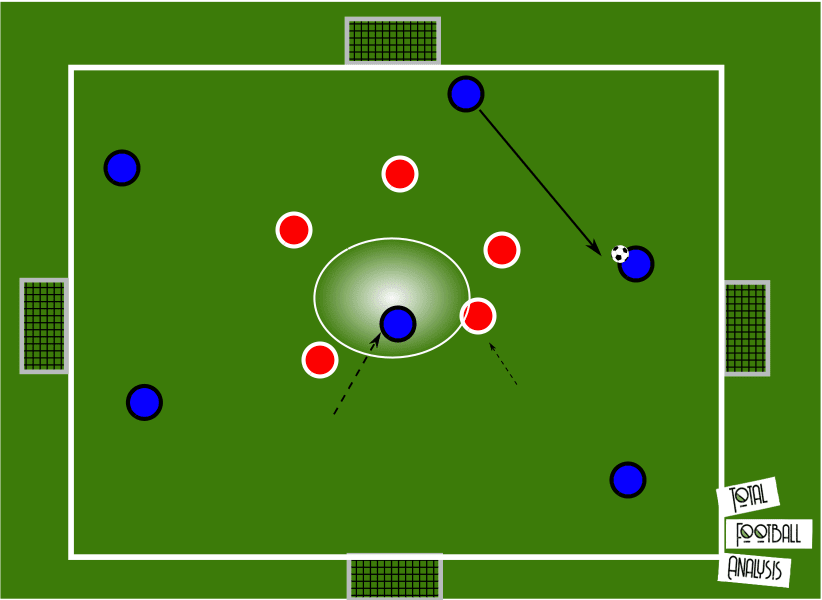
The defensive team needs to shift around the pitch and protect this central space. It must be large enough where it is difficult for the defensive team to just sit in front of it and protect all passing lines into it. Ideally, we want the defence to stagger their defence, not all shifting towards the ball.
If the defensive team is being split open too easily it is an excellent chance to step in and ask them about their team shape. For example, when there are three players in front of the centre circle, can the two players from behind them communicate to them and ensure they are covering passing lines.
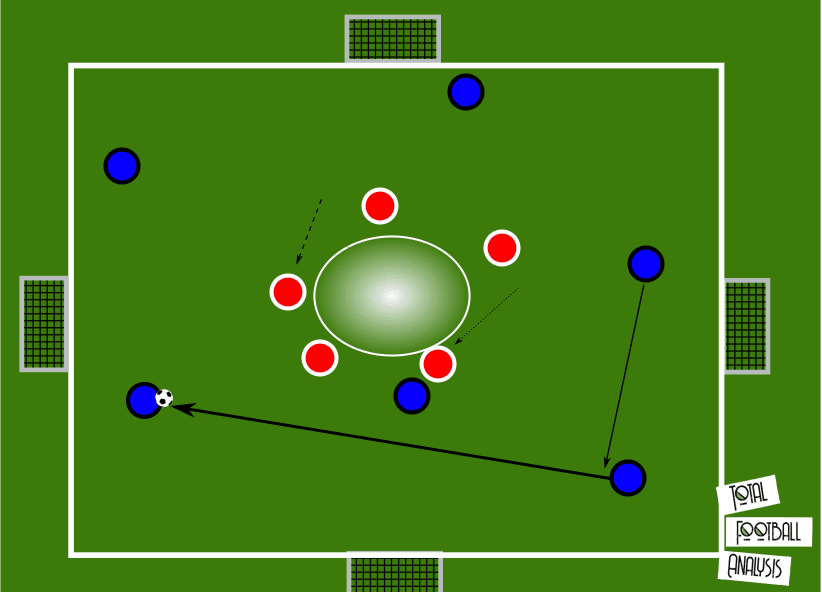
In order to prevent the defence from just sitting in front of the circle and barely moving as the opposition team circle possession a pass count can be put in place where the possession team can also score from connecting a number of passes. This doesn’t mean they have to connect this amount of passes before breaking into the circle, but it is another way to score a goal, and it will encourage the defending team to ensure there is some pressure on the ball. A relatively high number, between 10-15, would represent a good amount where it isn’t too easy to connect passes and simply notch up points without looking to penetrate the centre circle.
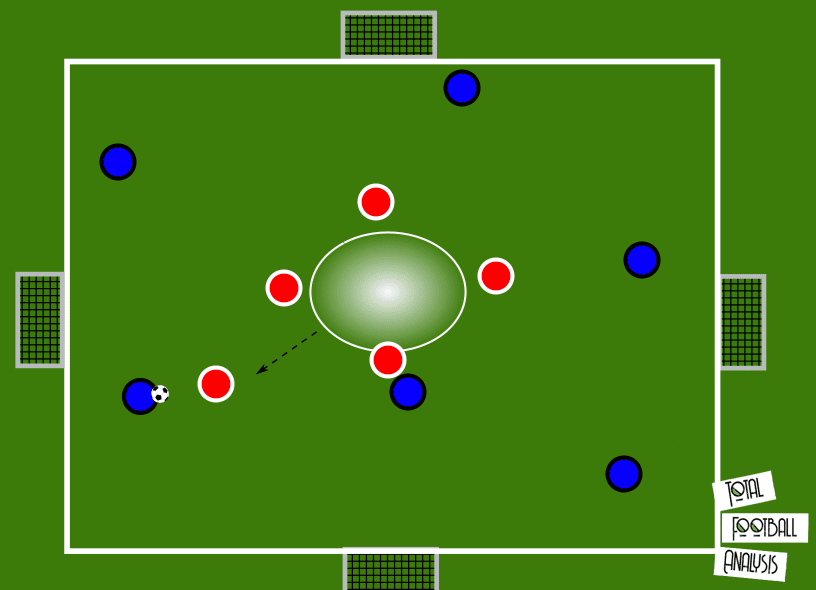
This practice is a good way to have the teamwork on shifting across the pitch, checking around them for potential space left open where the opposition could play a through pass through, and for filling in for one another if they are drawn out of position – all key traits needed to be successful when defending in a low block.
Part 2
We can bridge the gap between the first practice and our final practice – the phase of play – with part 2 using limited numbers, and creating a game-realistic situation occurring in the final third.
Just like previously, the defence are looking to prevent the opposition from accessing a specific space of the pitch, and to ensure it stays game-realistic and the defence don’t drop too deep, a zone can be put in place behind the penalty spot. This can go the full width or just be in place in the 18-yard box. The attacking team can score from anywhere but if they can receive in this space and finish, their goal will be worth two.
The defensive team can be prevented from accessing this space but personally it feels better to just encourage them to hold that line, and should a blue attacker move in too early, the coach can give it as an offside. When the defensive team win possession, there are two goals available for them to score into, themselves.
Finally, we will also see in the next image how there are five vertical channels in place. Building on our previous work of compactness in the coaching sessions shown in team defending part 2 and 3 of this series, the defenders can use this as a reference, looking to position themselves within the three closest vertical channels to the location of the ball – a great reference to provide a structure for compactness.
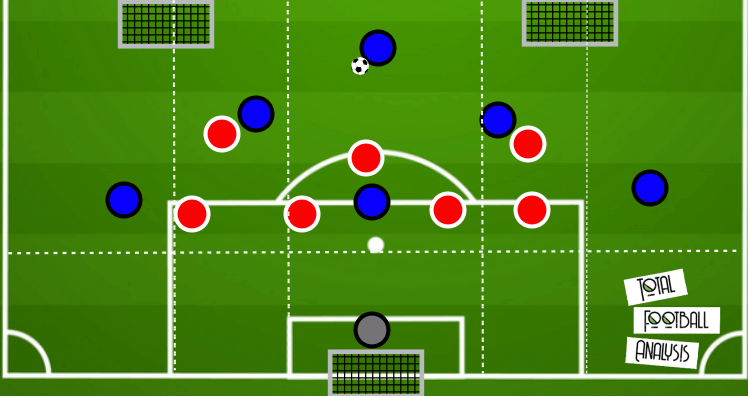
We can introduce a key phrase for the defensive team to achieve our goals here. “Shift and protect” or “slide and screen” are two phrases I have heard used to get this goal across of having the midfield shift across the pitch with the ball, and protect the space in front of their backline.
We want them to leave little space in between the lines where the attack will struggle to play past the midfield, and we want them to block passing lines, where the blue team may look to play a through pass through.
In the following image the ball has been circled to one side and the defence shifts over as do the midfield, again still operating within three channels of one another.
We want our midfielder close to the ball to provide pressure but not get so close they leave space inside. The position they have in the image shown is good because they are reducing the space the ball-carrier has but also preventing an inside pass. They haven’t overcommitted but are close enough where they could press if the ball-carrier looks to cross, for example.
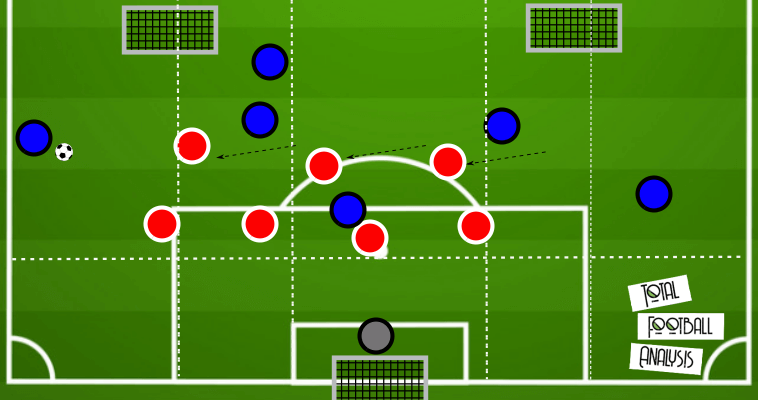
If the ball is circled once more, as it is in the next image, we can’t expect our midfield to continuously switch from side to side. First of all, this is going to quickly tire them out, but secondly they can’t get across quick enough to prevent the winger from attacking the space.
We can see this in the image shown below where the blue left winger has been afforded too much space to drive inside, towards the goal.
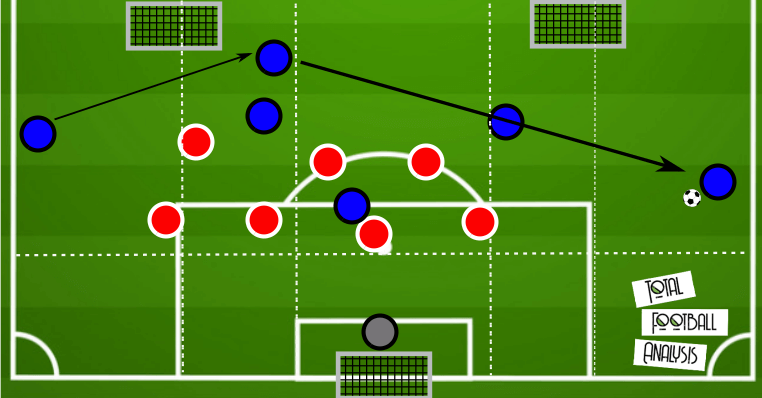
The right-back can be released to shift out wide and press the opponent. This leaves space between themselves and their inside centre-back, however, as long as the midfield are close to their defence they can shift across and the closest midfielder to the ball can drop into the defence, filling the space vacated by the right-back.
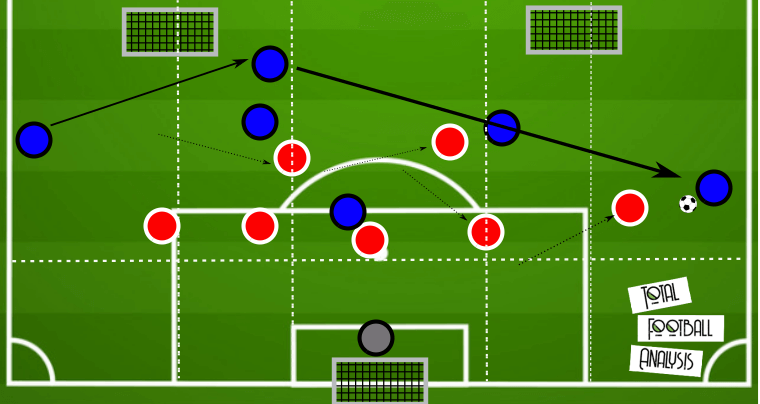
The attacking midfielders should be encouraged to attack this space when the full-back is drawn out, and the defence need to react to this.
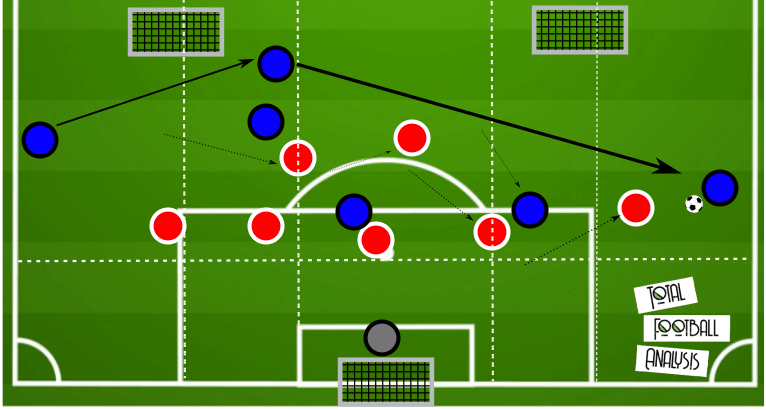
Part 3
Now the defence and midfield have been able to work on shifting across and having the midfield drop into the backline where necessary. The midfield should have an understanding of not getting pulled too far across either, working to provide some pressure to prevent too much space and time out wide, but most importantly protecting any easy inside passes into the central channel, and protecting the space in front of their defence. Given this learning has occurred we can move into a phase of play, and an 11v11 is a sensible progression to allow the defensive team to fully put this into practice before a game day.
We can see the red team defending in a 4-5-1 against the blue team attacking a 4-3-3.
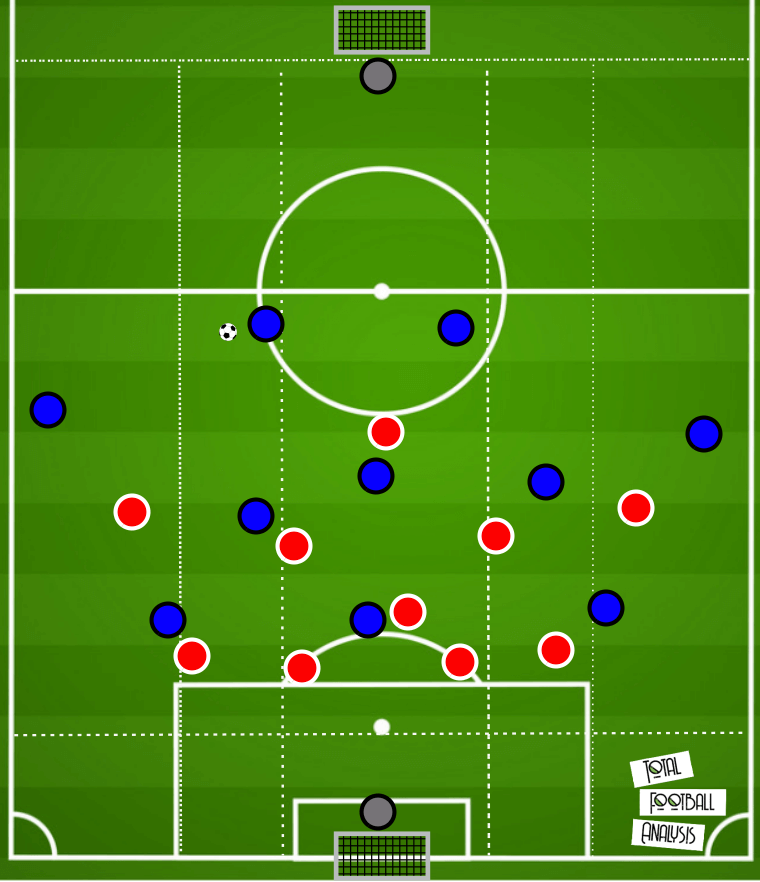
As before some form of offside line can be put in place, which we can see in the image below, but that isn’t necessary if you’re able to do the phase of play over a larger size pitch as the defence will naturally push forward.
As the attacking team circle possession we want to encourage the defensive team to shift across.
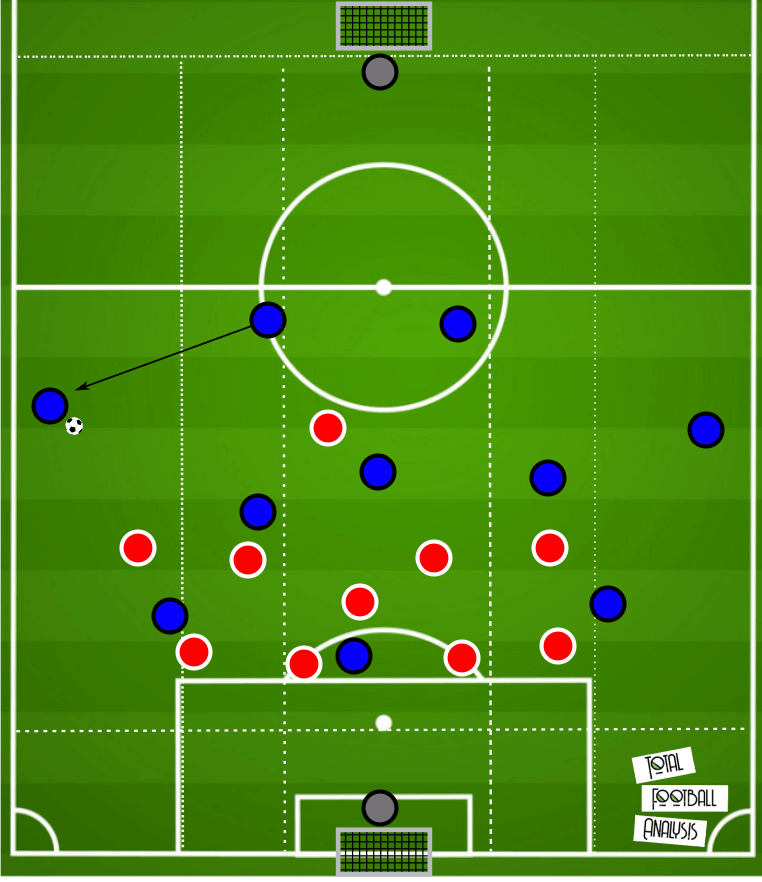
The winger can step wide to press the opponent, and in general can provide a presence out wide to prevent the attack advancing easily down the wing. Equally the full-back on that side can prepare themselves to step wide and engage the opponent if necessary. However, in order for the team to stay compact they of course need to shift across (once again ensuring they remain within three vertical channels of the ball). We can see in the following image that they haven’t achieved this.
One constraint that can be put in place is that only one player can shift wide to press an opponent unless everyone is within three channels. Once the winger and full-back on the other side tuck in, then the left-back in this example can step wide as well.
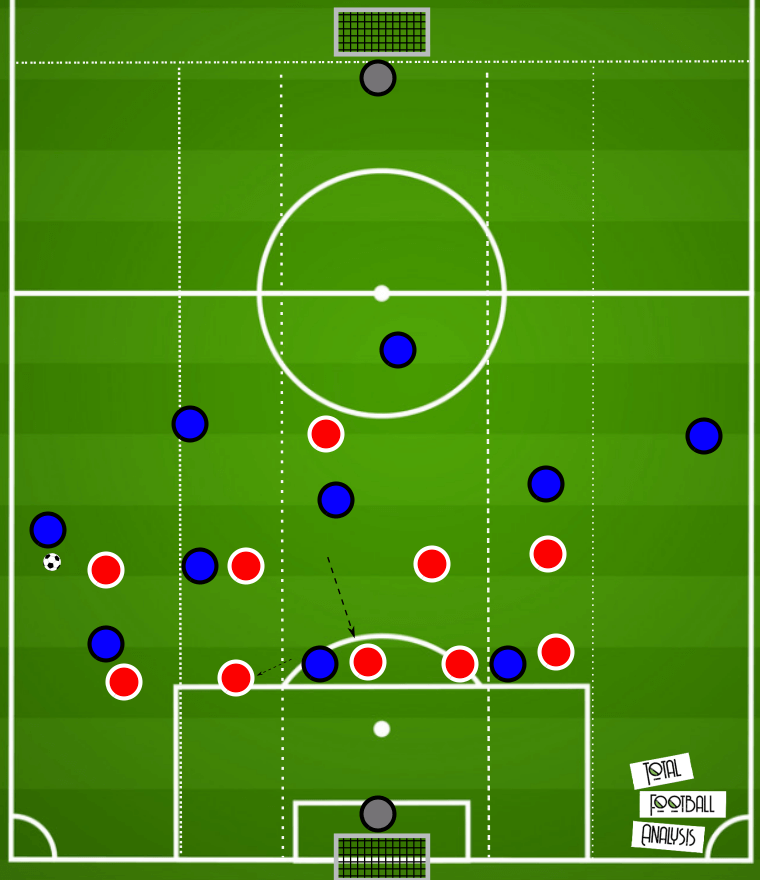
As the left-back shifts across the centre-back may choose to support, and perhaps the entire defence slides across. However, just like in the previous practice, the closes central-midfielder may look to drop into the back line – again, as long as his central-midfield teammates are still vertically compact with their defence.
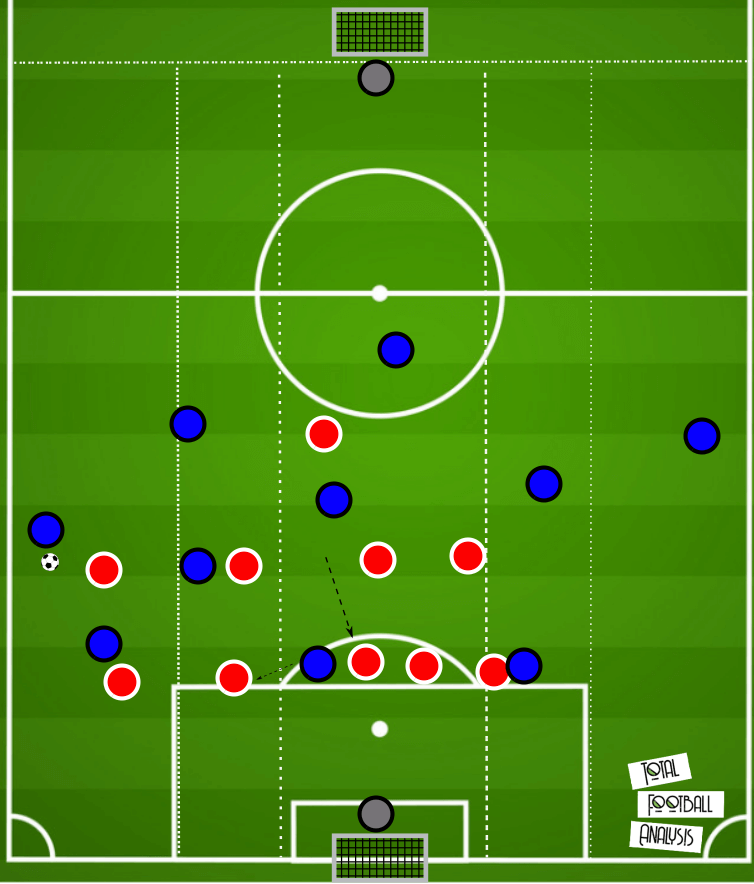
The final element worth looking to have your low block employ is relieving pressure. They can’t sit back continuously and let the opponent keep swarming them. When the opposition circle possession and play the ball backwards, the defence needs to step forward, moving themselves further from the own goal, and keeping compactness.
However, it is important they aren’t too aggressive with how they push forward. Firstly, if they are quick to step out and press the ball, they can leave too much space behind, which the opponent may look to quickly exploit. Playing the ball backwards like in the image below can be a tactic teams use to lure low-block defences out further than they may prefer.
Secondly, stepping forward quickly requires every single player in this block to push forward with the same pace. If not, spaces are going to open up in between the lines and again this can undo the low-block. If pushing forward at a more moderate pace, it is easier for the block to maintain its compactness.
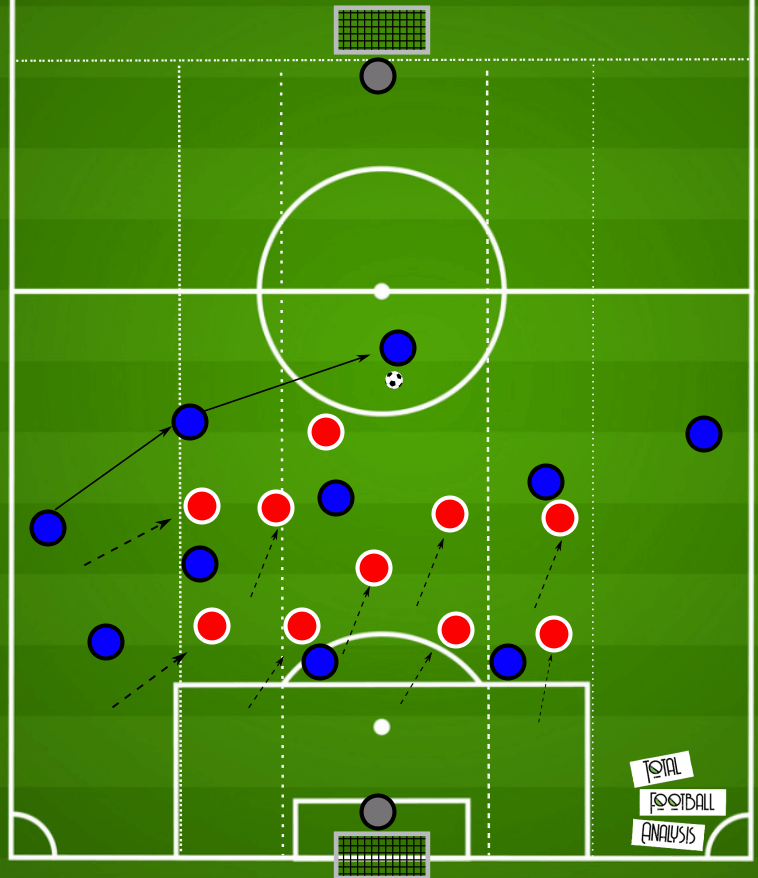
Conclusion
These practices provide a structure for a team to find success when defending in a low-block. By the end of this session they should be able to maintain compactness, both horizontally and vertically, and protect the opposition from accessing the central space. They will understand how to shift across as a unit and making it difficult for the opponent to successfully cross, whilst the central-midfielders will remain a relatively central position with one of them taking the lead to drop into the back line if a space opens up as the defence look to protect the width of the pitch. Finally, they should recognise when to step forward and take space away from the opponent, without being overzealous and leaving too much space behind.





Comments